24.2: Introduction to Ecology
- Page ID
- 17814
\( \newcommand{\vecs}[1]{\overset { \scriptstyle \rightharpoonup} {\mathbf{#1}} } \)
\( \newcommand{\vecd}[1]{\overset{-\!-\!\rightharpoonup}{\vphantom{a}\smash {#1}}} \)
\( \newcommand{\dsum}{\displaystyle\sum\limits} \)
\( \newcommand{\dint}{\displaystyle\int\limits} \)
\( \newcommand{\dlim}{\displaystyle\lim\limits} \)
\( \newcommand{\id}{\mathrm{id}}\) \( \newcommand{\Span}{\mathrm{span}}\)
( \newcommand{\kernel}{\mathrm{null}\,}\) \( \newcommand{\range}{\mathrm{range}\,}\)
\( \newcommand{\RealPart}{\mathrm{Re}}\) \( \newcommand{\ImaginaryPart}{\mathrm{Im}}\)
\( \newcommand{\Argument}{\mathrm{Arg}}\) \( \newcommand{\norm}[1]{\| #1 \|}\)
\( \newcommand{\inner}[2]{\langle #1, #2 \rangle}\)
\( \newcommand{\Span}{\mathrm{span}}\)
\( \newcommand{\id}{\mathrm{id}}\)
\( \newcommand{\Span}{\mathrm{span}}\)
\( \newcommand{\kernel}{\mathrm{null}\,}\)
\( \newcommand{\range}{\mathrm{range}\,}\)
\( \newcommand{\RealPart}{\mathrm{Re}}\)
\( \newcommand{\ImaginaryPart}{\mathrm{Im}}\)
\( \newcommand{\Argument}{\mathrm{Arg}}\)
\( \newcommand{\norm}[1]{\| #1 \|}\)
\( \newcommand{\inner}[2]{\langle #1, #2 \rangle}\)
\( \newcommand{\Span}{\mathrm{span}}\) \( \newcommand{\AA}{\unicode[.8,0]{x212B}}\)
\( \newcommand{\vectorA}[1]{\vec{#1}} % arrow\)
\( \newcommand{\vectorAt}[1]{\vec{\text{#1}}} % arrow\)
\( \newcommand{\vectorB}[1]{\overset { \scriptstyle \rightharpoonup} {\mathbf{#1}} } \)
\( \newcommand{\vectorC}[1]{\textbf{#1}} \)
\( \newcommand{\vectorD}[1]{\overrightarrow{#1}} \)
\( \newcommand{\vectorDt}[1]{\overrightarrow{\text{#1}}} \)
\( \newcommand{\vectE}[1]{\overset{-\!-\!\rightharpoonup}{\vphantom{a}\smash{\mathbf {#1}}}} \)
\( \newcommand{\vecs}[1]{\overset { \scriptstyle \rightharpoonup} {\mathbf{#1}} } \)
\( \newcommand{\vecd}[1]{\overset{-\!-\!\rightharpoonup}{\vphantom{a}\smash {#1}}} \)
\(\newcommand{\avec}{\mathbf a}\) \(\newcommand{\bvec}{\mathbf b}\) \(\newcommand{\cvec}{\mathbf c}\) \(\newcommand{\dvec}{\mathbf d}\) \(\newcommand{\dtil}{\widetilde{\mathbf d}}\) \(\newcommand{\evec}{\mathbf e}\) \(\newcommand{\fvec}{\mathbf f}\) \(\newcommand{\nvec}{\mathbf n}\) \(\newcommand{\pvec}{\mathbf p}\) \(\newcommand{\qvec}{\mathbf q}\) \(\newcommand{\svec}{\mathbf s}\) \(\newcommand{\tvec}{\mathbf t}\) \(\newcommand{\uvec}{\mathbf u}\) \(\newcommand{\vvec}{\mathbf v}\) \(\newcommand{\wvec}{\mathbf w}\) \(\newcommand{\xvec}{\mathbf x}\) \(\newcommand{\yvec}{\mathbf y}\) \(\newcommand{\zvec}{\mathbf z}\) \(\newcommand{\rvec}{\mathbf r}\) \(\newcommand{\mvec}{\mathbf m}\) \(\newcommand{\zerovec}{\mathbf 0}\) \(\newcommand{\onevec}{\mathbf 1}\) \(\newcommand{\real}{\mathbb R}\) \(\newcommand{\twovec}[2]{\left[\begin{array}{r}#1 \\ #2 \end{array}\right]}\) \(\newcommand{\ctwovec}[2]{\left[\begin{array}{c}#1 \\ #2 \end{array}\right]}\) \(\newcommand{\threevec}[3]{\left[\begin{array}{r}#1 \\ #2 \\ #3 \end{array}\right]}\) \(\newcommand{\cthreevec}[3]{\left[\begin{array}{c}#1 \\ #2 \\ #3 \end{array}\right]}\) \(\newcommand{\fourvec}[4]{\left[\begin{array}{r}#1 \\ #2 \\ #3 \\ #4 \end{array}\right]}\) \(\newcommand{\cfourvec}[4]{\left[\begin{array}{c}#1 \\ #2 \\ #3 \\ #4 \end{array}\right]}\) \(\newcommand{\fivevec}[5]{\left[\begin{array}{r}#1 \\ #2 \\ #3 \\ #4 \\ #5 \\ \end{array}\right]}\) \(\newcommand{\cfivevec}[5]{\left[\begin{array}{c}#1 \\ #2 \\ #3 \\ #4 \\ #5 \\ \end{array}\right]}\) \(\newcommand{\mattwo}[4]{\left[\begin{array}{rr}#1 \amp #2 \\ #3 \amp #4 \\ \end{array}\right]}\) \(\newcommand{\laspan}[1]{\text{Span}\{#1\}}\) \(\newcommand{\bcal}{\cal B}\) \(\newcommand{\ccal}{\cal C}\) \(\newcommand{\scal}{\cal S}\) \(\newcommand{\wcal}{\cal W}\) \(\newcommand{\ecal}{\cal E}\) \(\newcommand{\coords}[2]{\left\{#1\right\}_{#2}}\) \(\newcommand{\gray}[1]{\color{gray}{#1}}\) \(\newcommand{\lgray}[1]{\color{lightgray}{#1}}\) \(\newcommand{\rank}{\operatorname{rank}}\) \(\newcommand{\row}{\text{Row}}\) \(\newcommand{\col}{\text{Col}}\) \(\renewcommand{\row}{\text{Row}}\) \(\newcommand{\nul}{\text{Nul}}\) \(\newcommand{\var}{\text{Var}}\) \(\newcommand{\corr}{\text{corr}}\) \(\newcommand{\len}[1]{\left|#1\right|}\) \(\newcommand{\bbar}{\overline{\bvec}}\) \(\newcommand{\bhat}{\widehat{\bvec}}\) \(\newcommand{\bperp}{\bvec^\perp}\) \(\newcommand{\xhat}{\widehat{\xvec}}\) \(\newcommand{\vhat}{\widehat{\vvec}}\) \(\newcommand{\uhat}{\widehat{\uvec}}\) \(\newcommand{\what}{\widehat{\wvec}}\) \(\newcommand{\Sighat}{\widehat{\Sigma}}\) \(\newcommand{\lt}{<}\) \(\newcommand{\gt}{>}\) \(\newcommand{\amp}{&}\) \(\definecolor{fillinmathshade}{gray}{0.9}\)The red-tipped organisms in Figure \(\PageIndex{1}\) were discovered in 1977. Called tube worms, they live on the deep ocean floor, thousands of meters below the water’s surface. They cluster around hydrothermal vents that spew out hot mineral water. The environment around the vents would be deadly for most other organisms. Minerals in the vent water are toxic, the weight of ocean water above creates tremendous pressure, and it’s always very cold and completely dark. Without sunlight, photosynthesis isn’t even possible. Yet the vents support thriving communities of diverse species, many of which live nowhere else on Earth. Besides tube worms, they include equally strange ghost fish and crabs with eyes on their back. How have these organisms adapted to living in the harsh environment around hydrothermal vents? How do they obtain energy without sunlight and photosynthesis? How do the various vent species interact? Finding answers to questions such as these is the domain of ecology.
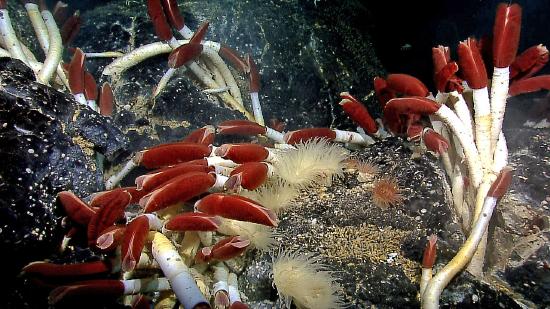
What Is Ecology?
Ecology is the study of how living things interact with each other and with their environment. Although it is a science in its own right, ecology has areas of overlap with many other sciences, including biology, geography, geology, and climatology. It is also closely related to genetics and ethology (the study of animal behavior). In addition, evolutionary concepts of adaptation and natural selection are the cornerstones of modern ecological theory.
Some of the phenomena that ecologists study include the interactions of organisms, the flow of energy and recycling of matter through living things, and the biodiversity and distribution of organisms relative to the environment. There are many practical applications of ecology. Among others, they include the conservation of endangered species (Figure \(\PageIndex{2}\)), natural resource management, urban planning, and human health.
Living Things and the Environment
Despite their tremendous diversity, all organisms have the same basic needs: energy and matter. These must be obtained from the environment. Therefore, organisms are not closed systems. They depend on and are influenced by their environment.
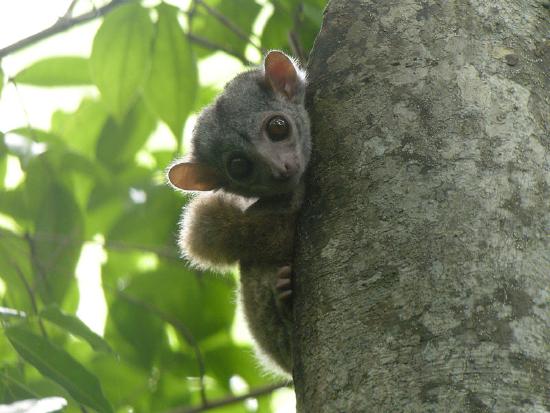
The environment of an organism includes two types of factors: biotic and abiotic.
- Biotic factors are the living aspects of the environment. They consist of other organisms, including members of the same and different species.
- Abiotic factors are the nonliving aspects of the environment. They include factors such as sunlight, soil, temperature, and water.
Consider as an example the relationship between leafhoppers and ants (Figure \(\PageIndex{3}\)). Ants “herd” leafhoppers and use their excretions for food, much as a dairy farmer herds cows and uses their milk. Leafhoppers suck sap from plants and excrete excess liquid as a sugary fluid called honeydew. As the honeydew passes out of a leafhopper’s anus, the ant “farmer” feeds on the fluid.
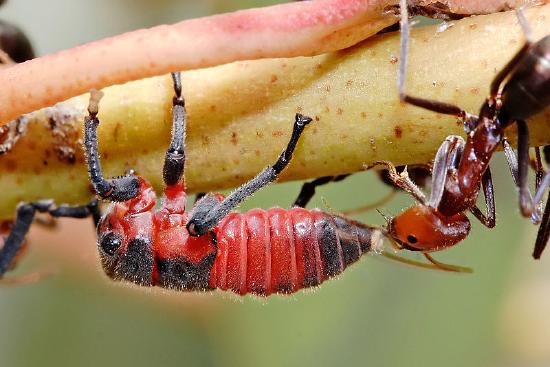
The leafhoppers in the “herd” also benefit from their relationship with the “ant.” The ant protects the leafhoppers from potential predators such as wasps. The amount of shade in the environment, which is an abiotic factor, is an important influence on the leafhoppers and ants. Environments with at least 50 percent shade are more densely populated by ants and leafhoppers than sunnier environments. Some species of “herder” ants even construct shelters to provide shade for their “herds.”
Ecological Hierarchy
Studying all living things and their environments would be a huge undertaking. Generally, the study of ecology is made more manageable by organizing the biological world into a nested hierarchy.
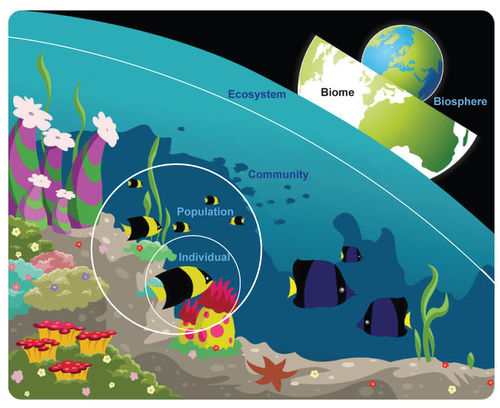
Ecology typically focuses on the living world at and above the level of the individual organism. These levels are illustrated in Figure \(\PageIndex{4}\) and defined as follows:
- A population consists of all the individual organisms of the same species that live and interact in the same area. For example, all of the angelfish living in the same area of the ocean make up the angelfish population.
- A community refers to all of the populations of different species that live and interact in the same area. The aquatic community that includes the angelfish also includes the populations of other species of fish, corals, and many other organisms.
- An ecosystem includes all the living things in a given area, together with the nonliving environment. The nonliving environment includes abiotic factors such as water, minerals, and sunlight.
- A biome is a group of similar ecosystems with the same general type of physical environment anywhere in the world. Terrestrial biomes are generally delineated by climate and major types of vegetation. Examples of terrestrial biomes include tropical rainforests and deserts. Aquatic biomes are generally defined by the distance from shore and the depth of water. Examples of aquatic biomes include the shallow water near shore (littoral zone) and the deepest water at the bottom of a body of water (benthic zone).
- The biosphere includes every part of Earth where life exists, including all the land, water, and air where living things can be found. The biosphere is the largest ecological category and consists of many different biomes.
Basic Ideas in Ecology
A number of concepts and principles are basic to the study of ecology. They include the ecosystem, niche, habitat, and competitive exclusion principle.
Ecosystem
The ecosystem is one of the most important concepts in ecology and often the focus of ecological studies. It consists of all the biotic and abiotic factors in an area and their interactions. While an ecosystem is a real system in nature, it is often artificially delineated by researchers. For example, depending on an ecologist’s research focus, a lake could be considered an ecosystem, but so could a dead log, like the one in Figure \(\PageIndex{5}\). Both the lake and the log contain a variety of species that interact with each other and with abiotic factors.
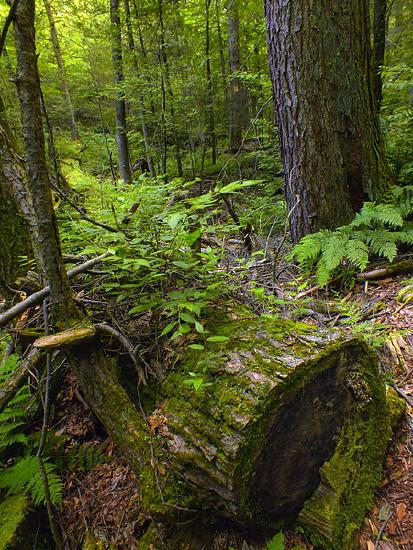
When it comes to energy, ecosystems are not closed. They need constant inputs of energy. Most ecosystems get energy from sunlight. A small minority, including hydrothermal vent ecosystems, get energy from chemical compounds. Unlike energy, the matter is not constantly added to ecosystems. Instead, it is recycled. Water and elements such as carbon and nitrogen are used over and over again.
Niche
One of the most important concepts associated with ecosystems is the niche. A niche refers to the role of a species in its ecosystem. It includes all the ways that the species interacts with the biotic and abiotic factors of the ecosystem. Two important aspects of any species’ niche are its sources of energy and nutrients and how it obtains them. For example, the jumping spider in Figure \(\PageIndex{6}\) is a carnivore (meat eater) that obtains food by preying on insects such as flies.
.jpg?revision=1&size=bestfit&width=328&height=249)
Habitat
Another fundamental aspect of a species’ niche is its habitat. The habitat is the natural environment in which a species lives and to which it is adapted. A species’ habitat includes any factors of the environment — including both biotic and abiotic factors — that are related directly or indirectly to the use of the environment by the species.
Species may have general or specific habitat requirements. For example, small white butterflies in the species Pieris rapae (Figure \(\PageIndex{7}\); on the left) are found on all continents of the world except Antarctica. Their larvae can feed on many different plant species, and the butterflies themselves thrive in any open location. In contrast, large blue butterflies in the species Phengaris arion (Figure \(\PageIndex{7}\); on the right) are found only in certain types of grassland areas. Their larvae can feed only on species in the plant genus Thymus. In addition, because of their complex life cycle, the butterflies can live only in areas in which certain ant species also reside.
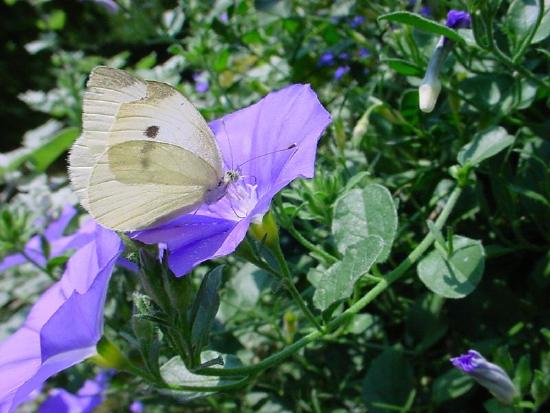
.jpg?revision=1&size=bestfit&width=300&height=225)
Competitive Exclusion Principle
A given area may contain many different species, but each species must have a different niche. Two different species cannot occupy the same niche in the same place for very long. This is known as the competitive exclusion principle. If two species were to occupy the same niche, what would happen? The two species would compete with one another for the same food or other limiting resources in the environment. Eventually, one species might outcompete and replace the other. Alternatively, one species might evolve somewhat different adaptations to a similar but different niche so they could continue to live in the same area.
Review
- Define ecology.
- Why are individual organisms not closed systems?
- Compare and contrast biotic and abiotic environmental factors, and give examples of each type of factor.
- Describe the nested hierarchy by which ecologists organize the biological world.
- What is the biosphere?
- Define ecosystem.
- Describe the niche concept in ecology.
- How is the habitat of a species defined?
- State the competitive exclusion principle.
- Compare and contrast the roles of energy and matter in an ecosystem.
- Which of the following can contain more than one species for an extended period of time? Explain your answer.
- A niche
- A community
- A population
- An ecosystem
- Do you think there can be an ecosystem in an urban environment, such as a city? Why or why not?
- True or False. The jumping spider and its prey occupy the same niche.
- True or False. The same type of biome can exist in different locations on the planet.
- Why is the study of climate-related to the study of ecology?
Explore More
Watch this video to learn about the importance of conservation.
Attributions
- Riftia tube worm colony Galapagos 2011, NOAA Photo Library, public domain via Wikimedia Commons
- Milne-Edwards' Sportive Lemur, Ankarafantsika, Madagascar by Frank Vassen, licensed CC BY 2.0 via Wikimedia Commons
- Common jassid nymph and ant by Fir0002/Flagstaffotos, CC BY-NC 3.0 via Wikimedia Commons
- Ecological levels by Christopher Auyeung via CK-12 licensed CC BY-NC 3.0
- Nurse log by Nicholas A. Tonelli, licensed CC BY 2.0 via Wikimedia Commons
- Jumping spider by James Niland, licensed CC BY 2.0 via Flickr
- Pieris rapae adult by Christian Bauer, CC BY 2.0 via Wikimedia Commons
- Silver Studded Blue by Pengannel, licensed CC BY 2.0 via Flickr
- Text adapted from Human Biology by CK-12 licensed CC BY-NC 3.0


